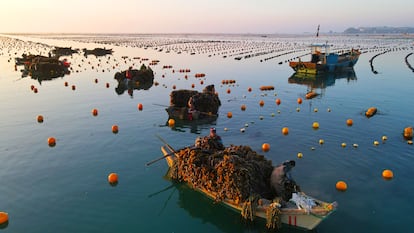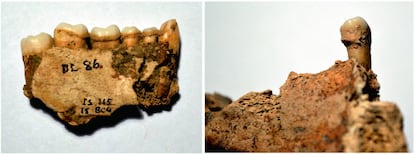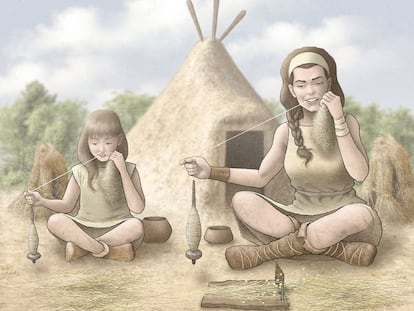Europeans already ate seaweed 8,000 years ago
Dental tartar analysis of human remains from the past shows that the consumption of aquatic plants in Europe was common until the Middle Ages

For millennia, if not earlier, ancient Europeans in coastal areas had algae and aquatic plants in their diet. Analysis of dental calculus or tartar from the teeth of dozens of human remains shows signs of consumption of marine and freshwater vegetables from Lithuania, in the north, to southeastern Spain from 8,000 years ago and at least until the Middle Ages. For reasons that the authors of the paper can only guess at, seaweed was abandoned and, until the recent Japanese food craze, was left for animals or times of famine.
Teeth are the remains of the body that best stand the test of time in the fossil record. There are human species that have been discovered from a few teeth and little else. At the extreme end of preservation are organic materials, such as food. Until not so long ago, the study of the past was the study of things that, because they were hard, could withstand the passage of time, such as tools and weapons made of stone and bone. But without the organic — without the fabrics they wore, without what they ate — key aspects of human prehistory remained obscured. Knowing what they ate, for example, would help to understand what they hunted, what they planted, what they traded or what they fought for. Hence, archaeologists turned to teeth to wrest all the information they had from them. In recent years, proteins from 1.7 million years ago and DNA from two million years ago have been recovered from some of them. Why not also study tartar? Dental calculus is nothing more than bacterial plaque that mineralizes. But in doing so, in a process of calcification, it makes the bacteria and whatever they were eating last for years, centuries or millennia.
This has been verified by a group of archaeologists and anthropologists. With the help of molecular biologists, they have been able to analyze the tartar of 74 individuals from about thirty archaeological sites throughout Europe. In half of them, they found identifiable food remains (in the form of chemical biomarkers). According to a study published this Tuesday in the scientific journal Nature Communications, the researchers found residues of animal fats, carbohydrates, unequivocal evidence of cooked food and, in one case, propolis, a resin made by bees. But they found something else. In 26 of the samples they found signs of algae and aquatic or riverside plants, such as the so-called sea cabbage, a food already recorded by the Roman historian Pliny the Elder in his writings.
Karen Hardy, a professor of prehistoric archaeology at the University of Glasgow (U.K.) and first author of the study, says that at the locations they sampled, “algae were widely present, particularly at [sites] close to the coast, while freshwater plants were consumed inland.” The earliest sample is from inland. At a site in present-day Lithuania and 100 kilometers from any sea, they identified in the tartar of one of the excavated sites the presence of a plant of the nymphaceae family, the same as that of water lilies. These teeth are from about 8,400 years ago, from the middle of the Mesolithic. The next trace is of algae (they have not been able to identify which) in the teeth of a woman between 35 and 40 years old found in the burial site of Casa Corona (Spain), who must have lived in the vicinity of the current Alicante city of Villena between 7,800 and 8,000 years ago. Previous works had already identified the consumption of mollusks. It is probable that they also consumed fish, but these tartars did not stand the test of time and isotope studies could not differentiate the marine origin. Now, the study of dental tartar adds algae to the diet of the inhabitants of the Mediterranean coast.
Stephen Buckley, an archaeologist at the University of York (U.K.) and also a co-author of Hardy’s study, notes that “the biomolecular samples in this study predate the historical evidence from the Far East by more than 3,000 years.” Perhaps seaweed was eaten earlier in Europe than in Asia. Buckley notes via email that chemical analysis of tartar “has the potential to reveal a wide variety of foods and, while it may not provide a complete picture of an individual’s diet, because some foods are more susceptible to degradation than others, it can still provide important information about ancient diets that can inform us about ancient trade networks, the availability of some products in antiquity, and even religious and political identity, since leaders have always used food as status symbols.”
Domingo Salazar, a researcher at the Department of Prehistory, Archaeology, and Ancient History of the University of Valencia (Spain), has investigated in detail the diet of the inhabitants of Casa Corona and others of the Iberian Peninsula. Regarding the consumption of mollusks, he warns that “it is not clear if they did it as food or as a decorative element.” Salazar values the use of tartar analysis in the new study “since it is a technique that detects compounds not detectable by others, such as isotopes.” The problem is qualitative, and he explains: “With the isotope study, if someone eats fish 10 times a year, this will not be reflected in the person’s collagen; it is a technique that requires regular and continuous consumption. But if someone puts a seaweed in their mouth, it can be trapped in the bacterial plaque, even if they were not going to eat it.”

If one were to take into account the proportion of positive samples of this research — 70% — the conclusion would be that the consumption of aquatic vegetables was very high among Europeans of the past. However, Hardy reminds us that this applies only to the sites they have studied, almost all of which are located on or near the coast. There are many other sites excavated inland where they have not studied the tartar in their human remains. But, as Juan Francisco Gibaja — who researches the sociology of past communities at the Spanish National Research Council — points out, Mesolithic societies were “the last hunter-gatherers.” Gibaja, who did not participate in Hardy’s study, adds: “In the Iberian Peninsula and throughout the Atlantic area, these groups settle, live, near the coast, because they have many resources available. And there is a lot of consumption of marine resources.”
In February of this year, York University scientist Maria Fontanals published another study showing that the inhabitants of the Iberian Mediterranean coast were already consuming seafood, particularly fish and shellfish, 9,500 years ago. Fontanals recalls that seafood was very important for the Paleolithic and Mesolithic people, “who were hunter-gatherers.” The problem is that until recently, the available technologies did not allow researches to detect this. “Until now, isotopic techniques only allowed us to see the dietary base of individuals. If the consumption of marine resources was less than the equivalent of 20% of the diet, we could not see this consumption,” explains the researcher. But biomolecular advances, such as those used with tartar, are beginning to reveal the importance of the sea in the paleodiet.
“When the Neolithic period arrived, this consumption decreased throughout Europe,” says Gibaja. Fontanals agrees: “We went from being in search of resources to eat all day long to growing our own food resources. This caused us to go from a heterogeneous and varied diet to a homogeneous diet based entirely on terrestrial resources.” The authors of the latest study agree with this assertion, and also point to the Neolithic revolution as the beginning of the end of algae consumption in Europe. However, they highlight that this decline was very slow. In fact, their study includes many samples from the Neolithic and Bronze Age, the Roman period and even the Middle Ages. In Natural History (AD 77-79), the Roman naturalist Pliny the Elder already sang the praises of sea cabbage, of which he writes: “It will remain green and fresh even during a long journey, if care is taken not to let it touch the ground from the moment it is cut.”
Buckley concludes that the introduction of agriculture “must certainly have had a profound impact on ancient diets, but our research suggests that perhaps the abandonment of seaweed and freshwater aquatic plants was not as complete as archaeologists and historians have suggested.” Hardy adds: “Laver bread, which is made from seaweed, is still consumed in Wales [U.K.]. We can only speculate as to why seaweed ceased to be consumed more widely. However, historical texts suggest that they were gradually devalued until they were left as food during famines and fodder for animals.”
Sign up for our weekly newsletter to get more English-language news coverage from EL PAÍS USA Edition
Tu suscripción se está usando en otro dispositivo
¿Quieres añadir otro usuario a tu suscripción?
Si continúas leyendo en este dispositivo, no se podrá leer en el otro.
FlechaTu suscripción se está usando en otro dispositivo y solo puedes acceder a EL PAÍS desde un dispositivo a la vez.
Si quieres compartir tu cuenta, cambia tu suscripción a la modalidad Premium, así podrás añadir otro usuario. Cada uno accederá con su propia cuenta de email, lo que os permitirá personalizar vuestra experiencia en EL PAÍS.
¿Tienes una suscripción de empresa? Accede aquí para contratar más cuentas.
En el caso de no saber quién está usando tu cuenta, te recomendamos cambiar tu contraseña aquí.
Si decides continuar compartiendo tu cuenta, este mensaje se mostrará en tu dispositivo y en el de la otra persona que está usando tu cuenta de forma indefinida, afectando a tu experiencia de lectura. Puedes consultar aquí los términos y condiciones de la suscripción digital.
More information
Últimas noticias
Most viewed
- Pablo Escobar’s hippos: A serious environmental problem, 40 years on
- Reinhard Genzel, Nobel laureate in physics: ‘One-minute videos will never give you the truth’
- Why we lost the habit of sleeping in two segments and how that changed our sense of time
- Charles Dubouloz, mountaineering star, retires at 36 with a farewell tour inspired by Walter Bonatti
- The Florida Keys tourist paradise is besieged by immigration agents: ‘We’ve never seen anything like this’











































